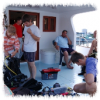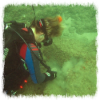ALEXANDRIA
ALEXANDRIA
ALEXANDRIA
The history of Alexandria, Egypt's second largest city, began in 332 BCE. Founded by Alexander the Great at the site of the small village of Rhakotis the city was planned as a stronghold of his vast empire. Alexandria’s strategic location was the primary factor in its rapid development as a leading Mediterranean commercial center. Its position on the Mediterranean coast allowed direct contact with all other seaports including the Greek colonies on the Black and Azov Seas. Furthermore canals connected Alexandria to the Nile and thus allowed trade with the far distant territories in the south of Egypt.
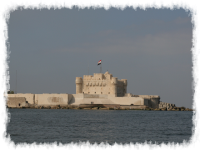
In fact Alexander the Great chose the only location on the whole Mediterranean shore that was suitable for building a port with the potential to become a principle center of commerce. The sandstone substratum provided a solid support for the city, and the island of Pharos, situated not far from the shore and mentioned by Homer in his Odyssey (4.351-586), protected the harbor against storms.
The first Ptolemies were faced with the difficult tasks of planning the port, layout of numerous harbor installations, construction of breakwaters, moorings, and constructing the famous lighthouse. At the same time the construction of the city continued under the supervision of an architect Dinocrates. Alexandria was divided into three quarters – the Greek, the Jewish and the Egyptian. The latter was probably situated on the territory of an earlier settlement. Alexandria soon became not only the capital of Egypt, but also a cultural center of the Hellenistic world. The famous Museum and the Library, which all scholars of antiquity longed to visit, were also situated there. Grandiose temples, where not only Egyptian, but also Greek gods were worshiped, were built in the city. Moreover, the first Ptolemies introduced a cult of a sycretic god, Sarapis, that incorporated a fusion of the cults of the Hellenized Egyptian deities Isis and Harpocrates as well as those of deified rulers.
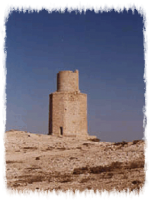
In 30 BCE, Egypt became a Roman provence. Alexandria remained the administrative center of the country and an important junction of Mediterranean trade. In particular, ships laden with Egyptian grain sailed from this port to Italy. Even after the collapse of the Roman Empire the city maintained its role as the granary of the Mediterranean.
In the course of time the city was seriously damaged by several powerful earthquakes. On the 3rd of August 1303 one of them destroyed the Alexandrian Lighthouse. The city also suffered from various civil conflicts. The famous Library of AlexanGreat activity of the earth’s crust in the area is proved by numerous geological faultsGreat activity of the earth’s crust in the area is proved by numerous geological faultsdria was probably burnt during the civil war of 48-47 CE. In 273 CE, the Emperor Aurelian destroyed the Library after the capture of the city. 700 thousand papyrus rolls kept in the so-called minor library of the Alexandrian Serapeum and that contained the of the burnt rolls perished during the plundering of this temple during the conflict between the traditional religions and Christians in 391 CE.

Underwater research in Alexandria
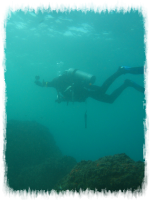
Important underwater research in Alexandria is carried out by the European Institute of Underwater Archaeology (IEASM – Institut Européen d’Archéologie Sous-Marine) under the direction of Franck Goddio. This work based on highly precise methods of spacial surveys has been conducted from 1996 until the present day. Thanks to these modern survey methods scholars were able to plot outlines of submerged land, ancient reefs and port structures. Collected data has allowed identifying the remains of ancient constructions including ancient ports.
The Centre of Alexandrine Studies (CEA – Centre des Etudes Alexandrines) headed by J.-Y. Empereur is another French institute performing underwater research in Alexandria. The work of the Center under water is focused on the vicinities of the medieval fort Qaitbey where possiblFragment of a colossal statue of one of rulers of Ptolemies dynastyFragment of a colossal statue of one of rulers of Ptolemies dynastye remains of the Pharos lighthouse are presumed to have been discovered. About 3000 building blocks and a fragment of a monumental sculpture were found here. The researchers discovered as well the remains of ancient shipwrecks seaward to the Qaitbey.
The Hellenic Institute of Ancient and Medieval Alexandrian Studies headed by Dr. G. Tzalas works to the East of the Great port of Alexandria on the other side of the Lochias peninsula (modern Silsileh). The concession of the Institute stretches for 14 kilometers along the coast. Remains of ancient buildings, a large accumulation of stone anchors and a fragment of a ship dated to the Roman period were discovered there.
In 2003 the Centre for Egyptological Studies of the Russian Academy of Sciences was authorised to study the zone, which extends from the Anfushi Bay to of the cape of Agami. The first season of the Russian underwater mission in Alexandria was held in April of the same year.

Territory of the Russian concesion

The territory of the concession is a vast area of water, exceeding 80 square kilometers. In Antiquity a port called Eunostos was situated at the site of a modern western port, which constitutes a portion of the concession. “Eunostos” can be translated as “The Port of a Happy Return” (Strabo, Geography, 17, I.10). It was mainly a trading port connected by a canal to Lake Mareotis by which commercial vessels could also reach the Nile. Unfortunately further work proved to be impossible there because of the high level of pollution and intense navigation on the surface.
n 1911-1915 a French engineer G. Jondet in the course of preliminary work preceding construction of new breakwaters conducted careful research in the coastal area of Alexandria and published the results of this survey. The information on the vestiges of ancient constructions summarized in an historical atlas shows their state before the rebuilding of the port and thus is of utmost value.
In particular, G. Jondet discovered remains of ancient harbor constructions at a depth of 10 meters facing the regions of Anfushi and Ras el-Tin. An Egyptian archaeologist A. Fakharani suggested that these constrThe team of season 2007 also included the members from the Underwater Confederation of Russia and FGUP “Nasledie”The team of season 2007 also included the members from the Underwater Confederation of Russia and FGUP “Nasledie”uctions could be a part of a complex of the famous Kybotos, an artificial harbour within Eunostos. 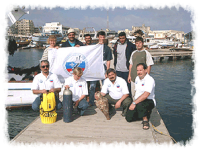
During the season of 2007 a number of reconnaissance dives were carried out on the outer side of the Ras el-Tin peninsula. They discovered and enabled the study of a massive ancient breakwater, consisting of limestone blocks, laid without mortar and filled with stone rubble.
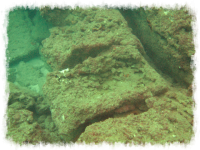
An application of spacial survey methods is necessary to concentrate efforts on several potentially interesting objects and that might become the main goal of forthcoming research. TPart of an ancient breakwater near the Ras el Tin peninsulaPart of an ancient breakwater near the Ras el Tin peninsulao cite just an example, an application of side scan sonar, that is not too efficient near the shore, gives good results on the sand bottom that starts at the depth of about 20 meters. Several ancient shipwrecks have been discovered by this method.
The results of this research give some probability of discovering the ruins of medieval fortifications built on the now submerged isles that once adjoined the port. Considering that the sea-level in Alexandria reached 8 meters one may also hope to find vestiges of submerged quarters of ancient and medieval Alexandriaии.
